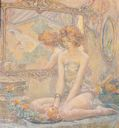Robert Reid
American
(1862 - 1929)
Artists in the late nineteenth century, particularly those Americans who studied in Europe, absorbed a broad spectrum of stylistic influences, and many became accomplished at painting in varying modes. Robert Reid’s career is indicative of this phenomenon, as he is known for producing both academic-style murals as well as Impressionist-style easel paintings. From 1880 to 1884, Reid studied at the Boston Museum School under the German painter Emil Otto Grundmann (1844–1890), who was a product of the art academy in Düsseldorf. Reid then continued his traditional academic art education at Paris’s Académie Julian. He painted in the summers at Etaples in Normandy, and traveled extensively in Italy during the late 1880s before returning to the United States in 1889. Reid settled in New York, and beginning in the early 1890s, he executed a number of architectural mural paintings on commission. He was closely associated with the architect Stanford White, who engaged him in 1890 to decorate his Imperial Hotel in New York City. Other prestigious commissions followed in quick succession. Murals for the Chicago World’s Columbian Exposition (1893), the Library of Congress (ca. 1896–97), and the State House in Boston (1901), all demonstrate the influence of Reid’s academic training in Paris, and his mastery of the Beaux-Arts tradition of the American Renaissance. (1) Reid received yet another major commission in 1915, when he painted murals for the domes in the Fine Arts Building at the Panama-Pacific Exposition in San Francisco. Simultaneously, Reid was exhibiting easel paintings in an Impressionist manner, and critics in the early 1890s grouped him with the American practitioners of the French style. (2) He joined and exhibited with the Impressionist group The Ten in 1898. Reid’s Impressionist canvases feature close-up views of elegant women, sometimes in contemporary dress but more often in attire that suggests no particular period. Floral and decorative attributes unite figure and background, creating a suggestion of sinuous movement. Reid characteristically used pale colors, allowing one tone to dominate in a composition.
(1) Reid executed murals for the North Corridor of the Great Hall on the second floor of the Thomas Jefferson Building of the Library of Congress. On the ceiling, he painted representations of the Five Senses—Taste, Sight, Smell, and Hearing and Touch. He painted circular murals on the walls depicting Wisdom, Understanding, Knowledge and Philosophy. See http://www.loc.gov/jefftour/secondfloor.html, accessed 1 September 2005, for more information and a reproduction of Wisdom.
(2) William H. Gerdts, "American Impressionism" (New York: Abbeville Publishers, 1984), p. 182.
American Paintings from the Montgomery Museum of Fine Arts, 2006, cat. no. 42, p. 116.
American
(1862 - 1929)
Artists in the late nineteenth century, particularly those Americans who studied in Europe, absorbed a broad spectrum of stylistic influences, and many became accomplished at painting in varying modes. Robert Reid’s career is indicative of this phenomenon, as he is known for producing both academic-style murals as well as Impressionist-style easel paintings. From 1880 to 1884, Reid studied at the Boston Museum School under the German painter Emil Otto Grundmann (1844–1890), who was a product of the art academy in Düsseldorf. Reid then continued his traditional academic art education at Paris’s Académie Julian. He painted in the summers at Etaples in Normandy, and traveled extensively in Italy during the late 1880s before returning to the United States in 1889. Reid settled in New York, and beginning in the early 1890s, he executed a number of architectural mural paintings on commission. He was closely associated with the architect Stanford White, who engaged him in 1890 to decorate his Imperial Hotel in New York City. Other prestigious commissions followed in quick succession. Murals for the Chicago World’s Columbian Exposition (1893), the Library of Congress (ca. 1896–97), and the State House in Boston (1901), all demonstrate the influence of Reid’s academic training in Paris, and his mastery of the Beaux-Arts tradition of the American Renaissance. (1) Reid received yet another major commission in 1915, when he painted murals for the domes in the Fine Arts Building at the Panama-Pacific Exposition in San Francisco. Simultaneously, Reid was exhibiting easel paintings in an Impressionist manner, and critics in the early 1890s grouped him with the American practitioners of the French style. (2) He joined and exhibited with the Impressionist group The Ten in 1898. Reid’s Impressionist canvases feature close-up views of elegant women, sometimes in contemporary dress but more often in attire that suggests no particular period. Floral and decorative attributes unite figure and background, creating a suggestion of sinuous movement. Reid characteristically used pale colors, allowing one tone to dominate in a composition.
(1) Reid executed murals for the North Corridor of the Great Hall on the second floor of the Thomas Jefferson Building of the Library of Congress. On the ceiling, he painted representations of the Five Senses—Taste, Sight, Smell, and Hearing and Touch. He painted circular murals on the walls depicting Wisdom, Understanding, Knowledge and Philosophy. See http://www.loc.gov/jefftour/secondfloor.html, accessed 1 September 2005, for more information and a reproduction of Wisdom.
(2) William H. Gerdts, "American Impressionism" (New York: Abbeville Publishers, 1984), p. 182.
American Paintings from the Montgomery Museum of Fine Arts, 2006, cat. no. 42, p. 116.
Artist Objects
